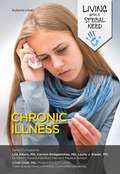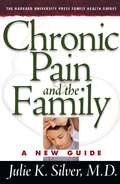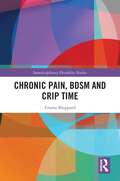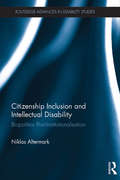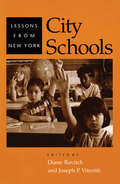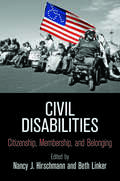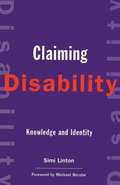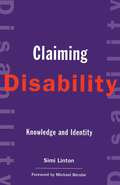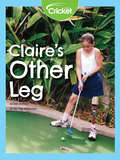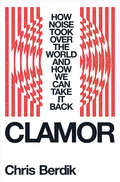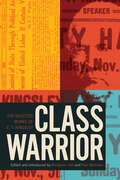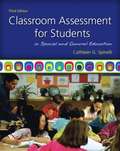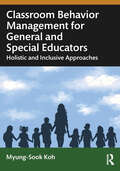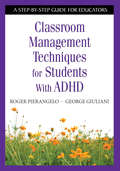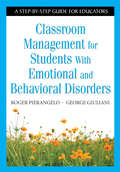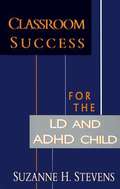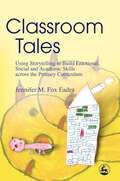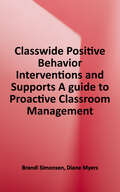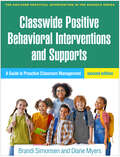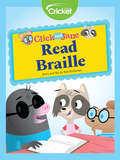- Table View
- List View
Chronic Illness
by Autumn LibalNot every sickness goes away in a few days or weeks. Unfortunately, some can last for months, years, or even the rest of a person's life. When this happens, it is called a chronic illness. It can cause many difficulties in people's lives, besides the illness itself. With some determination and help from friends and professionals, though, people with chronic illnesses can learn to face these challenges. Every young person faces challenges as they grow up, but those who have chronic illnesses have additional hardships. In this book, as you read Kayla's story, you'll learn about some of the difficulties these teenagers must overcome, and you'll discover some of the treatments and support systems that help them. Kids like Kayla have a tough time--but their lives can also be filled with hope!
Chronic Pain and the Family: A New Guide (The Harvard University Press Family Health Guides #1)
by Julie K. SilverChronic pain is the leading cause of disability in the United States, affecting as many as 48 million people in this country alone. It can demoralize and depress both patient and family, especially when there is no effective pain control and no hope for relief. Improperly managed, chronic pain can lead to substance abuse (usually painkillers) and to acute psychological and emotional distress. Pain begets stress and stress begets pain in a wretched downward spiral. Silver reviews the causes and characteristics of chronic pain and explores its impact on individual family relationships and on the extended family, covering such issues as employment, parenting, childbearing and inheritance, and emotional health. Silver treats aspects of chronic pain not covered in a typical office visit: how men and women differ in their experience of chronic pain, the effect of chronic pain on a toddler's behavior or an older child's performance in school, the risks of dependence on and addiction to pain medications, and practical ways for relatives beyond the immediate family circle to offer help and support to the person in pain.
Chronic Pain, BDSM and Crip Time (Interdisciplinary Disability Studies)
by Emma SheppardThis book is a critical disability studies examination of the lived experience of chronic pain, engaging with and making a significant contribution to crip theory and the concept of ‘crip time’. Exploring experiences of pain and fatigue for people who live with chronic pain and based on narratives told through in-depth detailed interviews interwoven with theory at the cutting edge of critical disability studies, it demonstrates that our knowledge and understanding of chronic pain is incomplete without a critical disability studies approach. Through conceptualizing the concept of ‘crip time’ via participants’ narratives of living with chronic pain, chronic fatigue, and variable disabilities, this book demonstrates how thinking about chronic pain and fatigue with ‘crip time’ exposes normative, ableist, assumptions underlying both how pain and the ideas of cure and recovery are understood. It will be of interest to all academics and students working in the fields of disability studies, critical disability studies, crip theory, medical sociology, sexuality, and studies of embodiment, corporeality, and temporality more generally.
Chuskit Goes to School!
by Sujatha PadmanabhanIn the Himalayas, there was a disabled nine-year-old girl, Chuskit, who wanted to go to school, study and do all the things her friends were doing. She however could not get out of her house, until one day Abdul decided to help her.
Circles of Care
by Ann Cason"Written from within the experience of caregiving, Circles of Care recognizes that no one person can handle the strain of caregiving alone, giving many fine suggestions on dealing with the irritation, frustration, and fatigue that inevitably arise. It describes the opportunity that caregivers have to know their subjects intimately and creatively, focusing not on weakness but on strength and on making constructive use of the interests and abilities still available in order to channel the tremendous energy that often remains after nearly everything else is gone."
Citizenship Inclusion and Intellectual Disability: Biopolitics Post-Institutionalisation (Routledge Advances in Disability Studies)
by Niklas AltermarkWhat happens when a group traditionally defined as lacking the necessary capacities of citizenship is targeted by government programs that have made ‘citizenship inclusion’ their main goal? Combining theoretical perspectives of political philosophy, social theory, and disability studies, this book untangles the current state of Western intellectual disability politics following the replacement of state institutionalisation by independent and supported living, individual rights, and self-determination. Taking its cue from Foucault’s conception of ‘biopolitics’, denoting the government of the individuals and the totality of the population, its overarching argument is that the ambiguous positioning of people with intellectual disabilities with respect to the ideals of citizenship results in a regime of government that simultaneously includes and excludes people of this group. On the one hand, its members are projected to become ideal-citizens via the cultivation of citizenship capacities. On the other, the right to live independently and by their own choices is curtailed as soon as they are seen as failing with respect to the ideals of reason and rationality. Therefore, coercion, restraints, and paternalism, which were all supposed to end with deinstitutionalisation, are still ingrained in services targeting the group. In equal parts a theoretical work, advancing debates of critical disability theory, social theory, and post-structural philosophy, as well as an empirical engagement with the history of intellectual disability politics and the ways in which present day politics target the group, this book will be of interest to all students and scholars of disability studies, disability politics, and political theory.
City Schools: Lessons from New York
by Diane Ravitch Joseph P. ViterittiHow the story of NYC's schools contain lessons for other cities.City Schools brings together a distinguished group of researchers and educators for an in-depth look at the nation's largest school system. Topics covered include the changing demographics of city schools, the impending teacher shortage, reading instruction, special education, bilingual education, school governance, charter schools, choice, school finance reform, and the role of teacher unions. City Schools also provides fresh and fascinating perspectives on Catholic schools, Jewish day schools, and historically black independent schools.Diane Ravitch, Joseph P. Viteritti, and their coauthors explore pedagogical, institutional, and policy issues in an urban school system whose challenges are those of American urban education writ large. The authors conclude that we know a lot more about how to provide effective educational services for a diverse population of urban school children than performance data would suggest.Contributors: Dale Ballou, University of Massachusetts, Amherst • Stephan F. Brumberg, Brooklyn College • Mary Beth Celio, University of Washington • Gail Foster, Toussaint Institute • Michael Heise, Case Western University • Clara Hemphill, Public Education Association • Paul T. Hill, University of Washington • William G. Howell, Harvard University • Pearl Rock Kane, Columbia University • Frank J. Macchiarola, Saint Francis College • Melissa Marschall, University of South Carolina • Thomas Nechyba, Duke University • Paul E. Peterson, Harvard University • Christine Roch, Georgia State University • Christine H. Rossell, Boston University • Marvin Schick, Avi Chai Foundation • Mark Schneider, SUNY, Stony Brook • Lee Stuart, South Bronx Churches • Paul Teske, SUNY, Stony Brook • Emanuel Tobier, New York University • Joanna P. Williams, Columbia University
Civil Disabilities: Citizenship, Membership, and Belonging (Democracy, Citizenship, and Constitutionalism)
by Nancy J. Hirschmann Beth LinkerAn estimated one billion people around the globe live with a disability; this number grows exponentially when family members, friends, and care providers are included. Various countries and international organizations have attempted to guard against discrimination and secure basic human rights for those whose lives are affected by disability. Yet despite such attempts many disabled persons in the United States and throughout the world still face exclusion from full citizenship and membership in their respective societies. They are regularly denied employment, housing, health care, access to buildings, and the right to move freely in public spaces. At base, such discrimination reflects a tacit yet pervasive assumption that disabled persons do not belong in society.Civil Disabilities challenges such norms and practices, urging a reconceptualization of disability and citizenship to secure a rightful place for disabled persons in society. Essays from leading scholars in a diversity of fields offer critical perspectives on current citizenship studies, which still largely assume an ableist world. Placing historians in conversation with anthropologists, sociologists with literary critics, and musicologists with political scientists, this interdisciplinary volume presents a compelling case for reimagining citizenship that is more consistent, inclusive, and just, in both theory and practice. By placing disability front and center in academic and civic discourse, Civil Disabilities tests the very notion of citizenship and transforms our understanding of disability and belonging.Contributors: Emily Abel, Douglas C. Baynton, Susan Burch, Allison C. Carey, Faye Ginsburg, Nancy J. Hirschmann, Hannah Joyner, Catherine Kudlick, Beth Linker, Alex Lubet, Rayna Rapp, Susan Schweik, Tobin Siebers, Lorella Terzi.
Claiming Disability: Knowledge and Identity
by Simi LintonDisability studies in the humanities curriculum
Claiming Disability: Knowledge and Identity (Cultural Front #14)
by Simi LintonA comprehensive assessment of the field of Disability Studies that presents beyond the medical to dig into the meaningFrom public transportation and education to adequate access to buildings, the social impact of disability has been felt everywhere since the passage of the Americans with Disabilities Act in 1990. And a remarkable groundswell of activism and critical literature has followed in this wake. Claiming Disability is the first comprehensive examination of Disability Studies as a field of inquiry. Disability Studies is not simply about the variations that exist in human behavior, appearance, functioning, sensory acuity, and cognitive processing but the meaning we make of those variations. With vivid imagery and numerous examples, Simi Linton explores the divisions society creates—the normal versus the pathological, the competent citizen versus the ward of the state. Map and manifesto, Claiming Disability overturns medicalized versions of disability and establishes disabled people and their allies as the rightful claimants to this territory.
Claire's Other Leg
by Deb AronsonClaire Williams was born with one leg much smaller than the other, but she doesn’t let that stop her from playing sports, jumping on trampolines, or wearing high heels! Read about how Claire is living a full life with the aid of a prosthetic leg.
Clamor: How Noise Took Over the World - and How We Can Take It Back
by Chris BerdikA May 2025 Next Big Idea Club Must-Read Book An eye- (and ear-) opening investigation into how our ever-noisier world affects our health, our well-being, and our planet. Early-morning jackhammering from construction down the block. The dull roar of jets flying overhead. Your office mates’ phone conversations. We are surrounded by noise, but it is a problem many of us shrug off once the immediate annoyance passes. Yet as gifted science journalist Chris Berdik explains in Clamor, noise can have serious health effects, disrupting our sleep, ratcheting up our stress, and destroying our concentration. As he argues, it is one of the most pervasive, yet underacknowledged, pollutants in our daily lives—one that we neglect, both individually and systemically, at our peril Drawing on extensive research and original reporting, Berdik shows how a too-limited understanding of noise, focused on loud sounds and decibel counts, has undermined a century of noise-control efforts and obscured the full toll noise exacts on us and the environment. Chronic exposure to noise that falls below decibel-based thresholds—sometimes even below our conscious awareness—is linked to spikes in the risk of heart disease and other serious health ailments that contribute to premature death. Noisy classrooms hinder developing minds and delay cognitive milestones. In forests and in the depths of the ocean, a cacophony of manmade sound disrupts the natural soundscape, threatening animals’ capacity to communicate, hunt, and flee predators. Yet in the battle against noise, sound doesn’t have to be our enemy: Berdik introduces us to the researchers, rock stars, architects, and many others who are finding surprising ways to make our world sound not only less bad, but better. Rising above the ever-increasing racket, Clamor is an urgent—and ultimately inspiring—call to finally take noise seriously and harness sound’s great potential.
Class Warrior: The Selected Works of E. T. Kingsley
by Eugene Thornton KingsleyIn October 1890, Eugene T. Kingsley’s life changed irrevocably when he was injured in a fall between two rail cars while working as a brakeman on the Northern Pacific Railway. Following the amputation of both his legs, Kingsley became radicalized and joined the Socialist Labor Party in San Francisco. His activism eventually brought him to Vancouver, B.C. where he founded the Socialist Party of Canada. A self-described “uncompromising enemy of class rule and class robbery,” Kingsley wrote prolifically on the exploitation of wage slaves by the capitalist class. Also known as a passionate orator, he went on to become one of the most prominent socialist intellectuals of his day. Class Warrior is a collection of Kingsley’s writing and speeches that underscores his tremendous impact on Canadian political discourse.
Classroom Assessment for Students in Special and General Education (Third Edition)
by Cathleen G. SpinelliClassroom Assessment for Students in Special and General Education is written for future teachers and experienced educators who are interested in developing or expanding their understanding of effective and reflective assessment practices. This new edition, with its emphasis on progress monitoring and early intervention, aligns well with the practical, authentic, and informal assessment procedures that have been--and continue to be--the heart of this edition and of past editions of this text.
Classroom Behavior Management for General and Special Educators: Holistic and Inclusive Approaches
by Myung-Sook KohThis comprehensive textbook outlines a holistic approach to inclusive classroom management. It critically examines the limitations inherent in behaviorism-based methods— particularly the Positive Behavior Interventions and Supports (PBIS) framework rooted in Applied Behavior Analysis (ABA)— and offers an alternative that integrates the full spectrum of student needs and the complexities of modern educational dynamics. Addressing the interconnected crises of falling academic standards, rising teacher turnover, and growing student behavioral and emotional challenges, the book presents a comprehensive, actionable strategy for accurately identifying classroom deficiencies and effectively responding to them in a student-centered way. Applicable to both special education and general educational contexts, Classroom Behavior Management for General and Special Educators is key reading for pre-service teachers in classroom and behavior management courses, as well as in-service teachers, teacher educators, and school administrators seeking new ways to address student behavior.
Classroom Management Techniques for Students With ADHD: A Step-by-Step Guide for Educators
by Roger Pierangelo George A. GiulianiDiscover practical methods for teaching students with Attention Deficit Hyperactivity Disorder, including effective strategies for classroom management, behavioral intervention, meeting legal requirements, and academic instruction.
Classroom Management for Students With Emotional and Behavioral Disorders: A Step-by-Step Guide for Educators
by Roger Pierangelo George A. GiulianiThis comprehensive guide covers typical emotional and behavioral disorder (EBD) behaviors, effective instructional interventions, positive reinforcement techniques, federal regulations, promoting healthy social interactions, and classroom management strategies.
Classroom Success for the LD and ADHD Child
by Suzanne H. StevensFor years, the assumption has been that it is mainly parents who need to be shown how to help their LD/ADHD children. This book is unique in its emphasis on educating teachers and other professionals as well as mothers and fathers—all those who must join efforts to lead LD/ADHD children to academic success. <p><p> Author Suzanne H. Stevens also knows the importance of recognizing the unusual creativity and other abilities found among LD/ADHD children, abilities long neglected by a system bent on forcing them into a mold they do not fit. <p> Stevens offers practical suggestions on: <p> recognizing the LD/ADHD child <p> adjusting teaching techniques <p> using specialists effectively <p> adjusting classroom management procedures <p> testing and grading fairly <p> The result is a balanced, optimistic look at ways of helping an increasing number of children reach their full potential in class.
Classroom Success for the Learning Disabled
by Suzanne H. StevensFrom The Book Jacket "Stevens has done it again! Her newest book on learning disabilities is lucid, accurate, insightful, practical, and it makes superb reading.... Her book provides the most helpful information I have seen for regular classroom teachers who are concerned with the realities and the nitty-gritties of helping LD children. My only regret is that the book has not been available for the last 20 years." DR. BARBARA BATEMAN University of Oregon "Stevens' book should be on the desk of every elementary and middle school teacher in every English-speaking country of the world. Stevens must have been an excellent classroom teacher, for she obviously understands both good elementary education and the learning-disabled child. Her book will go far to assist learning-disabled children toward a greater realization of their potentials." WILLIAM M. CRUICKSHANK, Ph.D. University of Michigan Between ten and twelve percent of the children in the U.S. are learning disabled. With such a large proportion of the population affected, the problem is not simply the concern of parents, LD individuals, and their teachers. It is the concern of society as a whole. In Classroom Success for the Learning Disabled, Suzanne Stevens discusses ways that we can help these children succeed in school and grow into productive adults. She offers practical suggestions on: Recognizing the LD child Adjusting teaching techniques Adapting texts and other materials Using LD specialists and psychologists effectively Adjusting classroom management procedures Testing and grading fairly Mainstreaming the LD child Stevens, a learning disabilities expert and a former classroom teacher, is the author of The Learning-Disabled Child: Ways That Parents Can Help. JOHN F. BLAIR, Publisher 1406 Plaza Drive Winston Salem, NC 27103 ISBN 0-89587-035-5 $8.95
Classroom Tales: Using Storytelling to Build Emotional, Social and Academic Skills across the Primary Curriculum
by Jennifer EadesStories and storytelling help children to develop emotional literacy, make sense of their world and appreciate different points of view. Fox Eades shows how storytelling is a crucial element of children's education that can enrich the school curriculum and encourage social and thinking skills. The author discusses the different kinds of story that are useful in the classroom context, including traditional stories, fairy tales and sacred stories, and explores the impact of individual and group dynamics on the telling and reception of these stories. She also considers recognised therapeutic uses of storytelling. She provides a series of sample stories and gives practical tips on adapting these to suit different situations and meet different needs. She also advises on a range of techniques such as using props, allowing `reflection' time and prompting interaction. Sections on collective stories and the child as storyteller explain how children can be inspired to compose their own tales that offer opportunities to practise self-expression and negotiation. This practical and engaging book provides all the tools and techniques needed to use storytelling effectively, and will be an essential resource for primary school teachers and others working with children in educational contexts, social workers and parents.
Classwide Positive Behavior Interventions and Supports: A Guide to Proactive Classroom Management (Guilford Practical Intervention in the Schools)
by Diane Myers Brandi SimonsenA vital classroom management resource, this book shows how to implement positive behavior interventions and supports (PBIS) in K-12 classrooms, regardless of whether PBIS is adopted school-wide. <p><p>The primary focus is universal (Tier 1) support for all students. Practical, step-by-step guidelines are provided for structuring the classroom environment, actively engaging students in instruction, teaching positive expectations, and establishing a continuum of strategies to reinforce positive behavior and respond to inappropriate behavior. <p><p>Numerous real-world examples and learning exercises are included. In a convenient large-size format, the book includes reproducible tools for class-wide PBIS planning and implementation, which can be downloaded and printed for repeated use.
Classwide Positive Behavioral Interventions and Supports: A Guide to Proactive Classroom Management (The Guilford Practical Intervention in the Schools Series)
by Diane Myers Brandi SimonsenNow in a revised and updated second edition addressing the evolving needs of today's K–12 educators, this established classroom resource is written by leaders in positive behavioral interventions and supports (PBIS). Brandi Simonsen and Diane Myers provide a vital classroom management and behavior support toolkit with a primary focus on universal (Tier 1) support. In a convenient large-size format, the book provides step-by-step guidelines for structuring the classroom environment, actively engaging students in instruction, setting clear expectations, and implementing a continuum of strategies to reinforce positive behavior and respond to inappropriate behavior. Teacher-friendly features include classroom vignettes, bulleted chapter objectives, end-of-chapter learning activities, and reproducible forms that can be downloaded for repeated use. New to This Edition Expanded focus on culturally responsive and inclusive practice. Increased attention to connecting with students and families and engaging them in designing, implementing, and monitoring practices. More coverage of integrating Tier 2 and Tier 3 interventions into a classwide PBIS model. Updated research, resources, tools, and examples throughout the chapters. This book is in The Guilford Practical Intervention in the Schools Series, edited by Sandra M. Chafouleas.
Clean to the Touch - Housekeeping for Teenagers and Young Adults with Visual Impairments
by Kathy Bull Susan Lind-Sinanian Eleanor MartinHousekeeping for Teenagers and Young Adults with Visual Impairments
Clear and Present Danger (Duncan Maclain Mystery #10)
by Baynard KendrickFrom the book jacket: Baynard Kendrick has returned to the Crime Club, bringing his famous and amazing blind detective with him-which is a promise that more stories of this favorite sleuth are coming. Absorbed in a chess game, Captain Duncan Maclain was unaware he was being watched by a thickset foreigner--which was a strange state of affairs, for Duncan's acute sensitivity usually compensated for his blindness. In any event, Duncan could not have known of the machinations that were suddenly to involve him in a plot as explosive as uranium and as exciting as a ticking geiger counter. That knowledge only came as he sat in a hospital ... and a man's breathing was silenced in a manner that put Duncan in a clear and present danger.
Click and Jane: Read Braille
by Rob McClurkanDo you know what Braille is? Learn along with Click and Jane as they meet a blind mole in their public library. Together, they learn from the mole that Braille is a way that helps blind people read and write! With the mole, they begin to understand that people can use Braille to read with their hands. Help Click and Jane celebrate the diversity in the world as they interact with their new friend! Now, if only they could keep their other friend CeCe quiet in the library…
